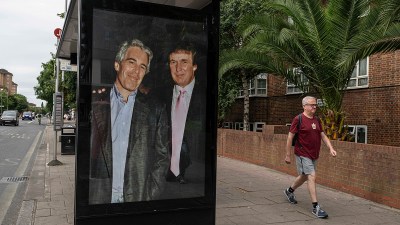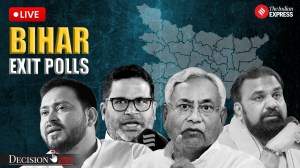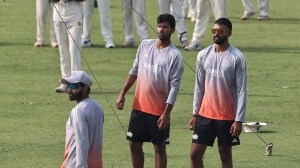Atri Mitra is a Special Correspondent of The Indian Express with more than 20 years of experience in reporting from West Bengal, Bihar and the North-East. He has been covering administration and political news for more than ten years and has a keen interest in political development in West Bengal. Atri holds a Master degree in Economics from Rabindrabharati University and Bachelor's degree from Calcutta University. He is also an alumnus of St. Xavier's, Kolkata and Ramakrishna Mission Asrama, Narendrapur. He started his career with leading vernacular daily the Anandabazar Patrika, and worked there for more than fifteen years. He worked as Bihar correspondent for more than three years for Anandabazar Patrika. He covered the 2009 Lok Sabha election and 2010 assembly elections. He also worked with News18-Bangla and covered the Bihar Lok Sabha election in 2019. ... Read More
‘Banglar Bari’: Mamata’s ambitious counter to Centre cutting of PMAY-G funds
Since 2014, the BJP-led Centre and the TMC’s West Bengal government have clashed repeatedly. Banglar Bari, a scheme that will see the state government fund the construction of pucca houses for eligible beneficiaries, is yet another outcome of this conflict
 West Bengal Chief Minister Mamata Banerjee inaugurates 'Jago Bangla Utsab Sankha' and release a music album written by herself, in Kolkata on Sunday. (ANI Photo)
West Bengal Chief Minister Mamata Banerjee inaugurates 'Jago Bangla Utsab Sankha' and release a music album written by herself, in Kolkata on Sunday. (ANI Photo)After Durga Puja, the West Bengal government will implement the second phase of the flagship “Banglar Bari” project in which 16 lakh families will be given Rs 1.20 lakh each to build pucca houses.
Chief Minister Mamata Banerjee had announced the scheme in 2024, two years after the Centre stopped funding the Pradhan Mantri Awas Yojana (Grameen) (PMAY-G) in West Bengal, after alleging massive corruption in its implementation, among other things.
Under the first phase of the Banglar Bari scheme, some 12 lakh families were given assistance of Rs 1.2 lakh in two installments to build houses.
Centre’s allegations
The funding for PMAY-G, at Rs 1.2 lakh per unit, is shared by the Centre and states at a 60:40 ratio (with the exception of Northeastern and Himalayan states, where the Centre bears 90% of the cost, and Union Territories, where the Centre bears all of the cost).
In 2022, the Centre stopped releasing PMAY-G funds to West Bengal citing massive corruption in the beneficiary list prepared in 2021, and taking objection to the state government changing the name of the scheme in Bengal.
In a letter sent to the state government in 2023, the Ministry of Rural Development stated, “…[The] following issues are still persisting in the State which have been observed by the Central Teams, NLM teams, Sr. Officers’ teams: Renaming of scheme as Bangla Awaas Yojana; Sanction of house to ineligible households; Deletion of names of eligible households; and Irregularities reported in the news articles/ media reports… Due to above cited major Issues, the Central Share of funds for targets from finalised Awaas+ (2018) lists (allocated in November, 2022) are not released to the State.”
The Centre alleged that while the state government had “accepted” that irregularities had occurred in the past and “committed to take corrective action”, it had not filed a First Information Report (FIR) against those allegedly involved in corruption regarding PMAY-G allocations, in spite of the Centre’s directions.
The state government, however, denies these allegations. “Whatever the Central government instructed, we implemented. We met the central delegation multiple times. Even the Chief Minister met the Prime Minister. But the Centre is still not ready to disburse funds,” a senior official of the State Panchayat and Rural Development department told The Indian Express.
Mamata’s pre-poll gambit
With the Centre not providing any assistance, Mamata while announcing the state Budget last year (for financial year 2024-25), said that the West Bengal government would foot the entire bill for constructing pucca houses under the Bangla Abas Yojna (BAY), more popularly called “Banglar Bari” mission, from December 2024.
A senior leader of the Trinamool Congress told The Indian Express that this “is a great example of self-sufficiency of the government ahead of next year’s Assembly election”.
“It will help our campaign against the BJP and their anti-Bengal attitude. Simultaneously, we will prove that our government has a positive will to work for the poor people,” the leader, also a member of the state cabinet, said.
He did not mince words when it comes to the political benefits that the TMC hopes to reap from this scheme. “…those who are getting “Banglar Bari” will vote for us. In two phases, the state government is giving some 28 lakh families a pucca house. This amounts to almost one crore beneficiaries. (Bengal’s population is estimated to be around 10 crore in 2025),” he said.
After the completion of the first phase of “Banglar Bari”, the TMC’s campaign focussed heavily on the theme of self-reliance.
“Bengal is self-reliant. We don’t need the Centre’s charity. With Awas Yojana funds frozen by the Modi government, [Mamata] launched Banglar Bari. Now, the second installment of Rs 60,000 is being rolled out to 12 lakh families, totaling Rs 14,400 crore,” the party’s official handle posted on X.
New SOPsOn September 15, the state published a new Standard Operating Procedure (SOP) for the second phase of “Banglar Bari”, designed to curb corruption and streamline the process. Among other things, it comprises: Story continues below this ad * Details regarding eligibility criteria. Applicants must not already own a pucca house and should not fall under other exclusion categories. These include: ownership of motorised/agricultural vehicles, a household with government employees, a household running registered non-agricultural enterprises, an income above Rs 15,000 per month or paying Income/Professional Tax, the ownership of 2.5 acres or more irrigated land or 5 acres or more unirrigated land, and families who have already benefited from any housing scheme. Beneficiaries must be on the waiting list prepared after field verification in FY 2024–25, subject to another round of reassessment. * Process for re-verification. For the verification process to finalise a list of beneficiaries, the SOP emphasises door-to-door checks by “superior officials at Block, Sub-division and District levels in every Gram Panchayat”, with at least one team per Gram Panchayat. Notably, the SOP states that these teams will be held accountable for “errors or negligence”, and “disciplinary action will be initiated in case of lapses”. “Teams shall collect the household list from the BDO office and re-verify eligibility at the household level. All re-verification shall be conducted using the designated mobile application. Documents such as Aadhaar, Bank/Post Office account details, and mobile numbers shall be re-verified… Verification shall be video recorded. Two photographs (including geo-referenced images of the existing house and proposed site) shall be uploaded. The District Administration shall ensure necessary publicity, logistics and law & order support,” the SOP reads. * Grievance redressal mechanism. Grievances “must be addressed within five working days,” it states, anticipating that complaints may be filed through petitions, the Sorasori Mukhyamantri platform, PGRS portal, emails, complaint boxes, control rooms, or media. Story continues below this ad * Process to minimise corruption. In order to minimise corruption, the SOP stipulates control rooms with 5-6 staff in BDO, SDO, and DM offices, in order to contact every beneficiary before and after verification, with calls logged “systematically”. The SOP states: “…The house shall be constructed by the beneficiary with or without additional contribution from his/her own resources. Provision of basic amenities such as toilets, electricity, drinking water, and linkage with Anandadhara shall be ensured through convergence with various schemes.” |
Centre vs West Bengal
This is yet another outcome of the longstanding conflict between the BJP-led government at the Centre and Mamata’s government in West Bengal. While the BJP, over the past few state Assembly and Lok Sabha elections, has made inroads into the state, Mamata’s TMC remains dominant even in the face of many crises.
This Centre-state conflict has manifested in various forms: from the Governor holding up bills passed in the state legislature to the Centre alleging that the TMC is supporting illegal immigration of “Bangladeshis” to the (stoppage of) disbursal of central funds to the state.
Notably, PMAY-G is not the only central scheme for which funds are not being disbursed to West Bengal. Chief Minister Mamata Banerjee on Sunday (September 21) alleged that the Centre has held up allocations of more than Rs 1.5 lakh crores to West Bengal.
The Centre stopped funding MGNREGS from December 2022, again citing allegations of massive corruption. Despite orders from the Calcutta High Court in June to restart the scheme in the state by August 1, MGNREGS remains inactive in West Bengal. The Centre has now approached the Supreme Court against the Calcutta HC order.
Over the last 13 months, the Centre has also stopped disbursing funds for the Jal Jeevan Mission. According to the Centre, the West Bengal government did not spend the amount allocated to it in the Union Budget, and as a result has not received a “utilisation certificate”.
While the state government accuses the Centre of having an “anti-Bengali” attitude and trying to make the people of Bengal suffer due to political vendetta against the TMC, the Centre has repeatedly alleged that Mamata’s government is corrupt, with schemes being used to enrich party-workers and supporters.
Such allegations also emerged during the first phase of the Banglar Bari scheme, when protests broke out in South and North 24 Parganas, Purba and Paschim Bardhaman, Birbhum, East and West Midnapore, Malda, and Murshidabad last October-November.
Protestors alleged that those genuinely eligible were not being included in the beneficiaries list, which favoured supporters and workers of the TMC and systematically excluded those with the opposition party (the BJP).



- 01
- 02
- 03
- 04
- 05




































